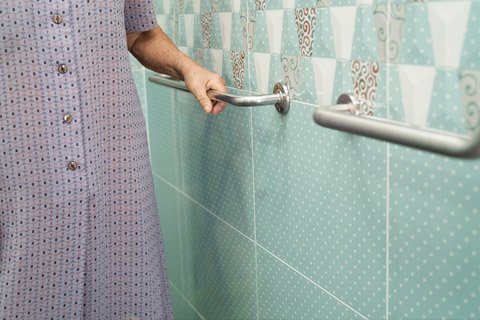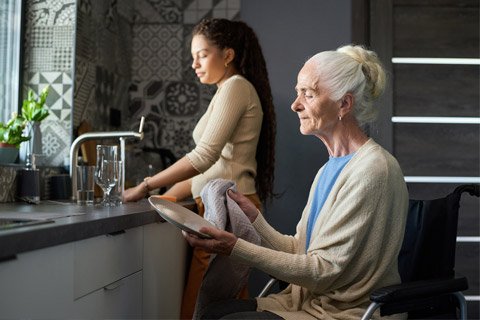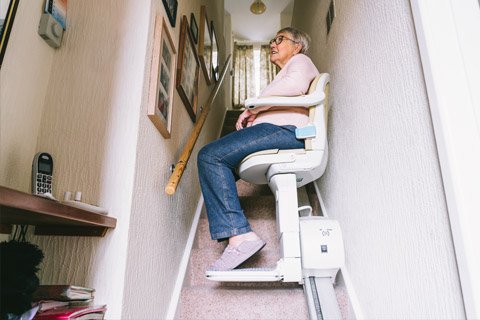As our loved ones are getting older, it’s natural for us to be worried about their safety and wellbeing. Whether it’s their day-to-day routine or occasional activities, there are a whole range of factors posing a potential risk to elderly people, especially when living by themselves. Some older adults also start to find certain routine tasks and aspects of daily living more challenging over time, which can make it more difficult to carry these out as they’d like.
While it’s important to address all of our concerns and prevent potential health and fall risks, it’s equally vital to respect elderly people’s privacy, supporting a sense of autonomy and dignity in their lives.
In this article, we’ll explore some of the popular independent living aids for seniors – equipment designed to enhance elderly people’s lives while reducing the risks of common health and safety hazards. From simple home adaptations to mobility products for the elderly, these tools can make older adults’ lives more enjoyable while giving you peace of mind.
Jump to:
- Home adaptations for elderly people
- Adjustable furniture for older adults
- Free mobility aids for the elderly
- Personal alarms and key safes
1. Home adaptations for elderly people
One of the primary concerns when it comes to seniors is ensuring their living space is safe and accessible. By making small home adaptations and security adjustments, you can help your senior relatives or loved ones navigate safely around their homes while maintaining their independence and respecting their privacy.
Grab bars and handrails
From the bathroom and hallway to the staircase and kitchen, these can be some of the most important areas in elderly people’s homes to consider, as they present the risk of falls and slips.

Installing grab bars and handrails around these areas can significantly enhance safety, providing seniors with more stability and assisting them when maintaining their balance.
Enhanced lighting
Poor interior lighting can increase the risk of accidents and falls, especially for seniors with visual impairment. Installing bright, glare free lights around seniors’ homes can contribute to overall safety in rooms and working areas, increasing visibility and preventing the risk of accidents.
You might also want to consider complementing their homes with motion-activated lights that switch on automatically when a person enters a room or leaves bed, and then switch themselves off after a set amount of time.
Bathroom modifications
Bathrooms are one of the most crucial areas to consider when making home adaptations for elderly, as the space presents the risk of slips and falls due to slippery surfaces and potential limited mobility.
To improve the safety of elderly people in this area of the home, you can consider implementing some of the modifications below:
- Replace a classic bathtub with walk-in shower or use a bath adaption to make it easier to get in and out
- Complement the walk-in shower with a shower seat
- Use non-slip flooring, or cover the floor with non-slip mats
- Add grab bars and handrails
- Install lever action taps so they are easier to turn on and off without needing to grip them
- Switch from a standard toilet seat to a raised seat
Tips on bathroom design for elderly relatives
You can learn more about bathroom safety modifications in our article on Bathroom design for elderly relatives.

Kitchen adjustments
Similarly, a kitchen area can pose various challenges to elderly people, with potential hazards including sharp objects, hot surfaces or slippery floors.
These are some of the key kitchen adjustments to help you make sure seniors keep safe during their meal preparation:
- Multi-levelled countertops to meet seniors’ needs while standing as well as sitting
- Easy to grip kitchen utensils to help elderly with a weaker grip
- Perching stool to help take off elderly people’s weight during meal preparation
- Trolleys and non-slip trays for carrying meals safely
If you need more useful advice on adjusting the kitchen for your elderly relatives, you can check our kitchen safety tips for seniors.
If you live with an elderly or disabled person and want to improve their safety at home, you can submit a request to your local council, as they offer a free service that assesses your home and recommends equipment or adaptations.
2. Adjustable furniture for older adults
Alongside making small adjustments in your home, furniture that features adjustable levels or heights can play a key role in creating accessible, independent living for elderly people. While providing seniors with features to get in and out of the furniture more easily and perform some of their daily activities safely and with ease, adjustable features can also accommodate people with temporary health conditions and injuries as they recover.
The most common adjustable furniture includes:
Adjustable beds
By providing a range of features to customise the height and position of the sleeping surface, adjustable beds can suit individual comfort preferences and health needs. Additionally, adjustable beds make it easier for seniors to get in and out of bed safely, reducing the risk of falls and strain.
Lift and recliner chairs
These adjustable chairs are equipped with a motorised lift mechanism, assisting elderly people when standing up from a seated position. Recliner chairs can also help some seniors relax their muscles and improve their posture when sitting, making sure they are safe and comfortable while spending time at home.

Stairlifts
Stairs can become a serious obstacle for the elderly, especially for those with mobility issues and physical disability. Stairlifts are devices designed to transport individuals between different levels of a building. They are equipped with a number of features for smoother operation and better comfort, allowing users to move around multi-level homes securely and independently.
Overall, while some adjustable features might require a larger initial investment, their benefits in terms of safety, comfort, and independence for seniors are invaluable.
Before making the final decision on which device might be the most suitable for your needs, it’s worth exploring available schemes, grants, and assistance programs that can help offset the costs of implementing these features.
3. Free mobility aids for the elderly
While making home adaptations for the elderly can be an effective way to reduce health and injury hazards and enhance seniors’ safety, some of the adjustments might require a significant financial investment.
However, it’s important to note that there are a range of free mobility aids for the elderly that can sometimes be provided by the NHS or a local council.
These mobility aids include:
Walking sticks
Walking sticks can provide extra support to elderly people, giving them more confidence when moving around and reducing the risk of falls or losing balance.
You can usually speak to your GP, physiotherapist or hospital staff to borrow a walking stick from the NHS, paying only a small deposit. Alternatively, you can purchase a walking stick from a mobility shop in your area.
Walking frame
Walking frames serve as an additional balance for elderly people while walking or moving around, providing more support than a walking stick.
Similar to a walking stick, you can often either borrow a walking stick from the NHS or purchase the aid from mobility shops.
Wheelchairs and mobility scooters
Wheelchairs and mobility scooters provide a solution for people who struggle to walk or suffer from a serious physical disability, allowing them to move around, use public transportation or enter buildings.
There are different ways of getting a wheelchair, and depending on your condition and circumstances:
- You can get a medical reference from a GP to your local wheelchair service provider, who will assess your situation and decide whether you need a wheelchair and if so, what type.
- You can also refer yourself directly to a wheelchair provider or your local integrated care board.
- In case of a short term condition, you can also borrow a wheelchair from the NHS or hire the aid from the Red Cross.
- And finally, you can purchase a wheelchair and get help with the cost by using one of the available schemes, such as Motability Scheme.
While wheelchairs are a good solution for elderly people to move around, mobility scooters are hugely beneficial when travelling longer distances, allowing seniors to keep their independence and remain connected to the outside world.
Mobility scooters are generally not available on the NHS, but similar to getting a wheelchair, you might be able to receive financial support from available schemes and grants.
Electric wheelchair vs mobility scooter
If you’re unsure how to choose your mobility device, compare the differences between electric wheelchairs and mobility scooters and their benefits.
4. Personal alarms and key safes
While mobility products for the elderly can enhance their quality of life and independence, there are also a range of innovative digital devices helping families and caregivers monitor the elderly’s health, safety and overall wellbeing.
From personal alarms to key safes and smart home monitoring, all these technologies provide you with personalised support tailored to each family’s needs and can enable you to respond quickly to emergencies.
Personal alarms
Working as a portable unit with a button to call for assistance, personal alarms are designed to raise an emergency alert in case of a fall or other urgent situation. At TakingCare, we offer a range of personal alarms and fall alarms, tailored to suit your family's needs.
Smart home monitoring
Smart home monitoring is an ideal solution for elderly people living independently, keeping your loved ones safe while providing you with reassurance when you can’t be there with them.
It’s a non-intrusive, low-maintenance system that monitors the seniors’ daily routine and can raise an alert if normal behaviour changes or if the temperature in the home reaches an usually low or high level .
Smart monitoring systems have multiple types of functionality, including movement sensors, fire safety or electronic device monitors, raising an alert in case of unusual behaviour or potential danger.
Key safes
Key safes are secure storage boxes designed to hold spare keys to the home, allowing emergency services, carer, trusted neighbours or family members to quickly access a senior’s home in urgent situations.
Available as an addition to personal alarms, our key safes are original, police-accredited devices that can be fitted to any brick built or concrete external wall.
If you’re looking for advice on how to introduce a personal alarm to your elderly family members, you can read our blog on How to talk to your mum and dad about getting a personal alarm.
To help you support older adults living alone, we’ve also prepared a guide on How to promote independence in the elderly.
If you want some assistance with choosing the right personal alarm or key safe for your family or situation, our Independent Living Advisors are happy to help. Call us on freephone 0800 085 7371, Monday - Friday, 9am - 6pm.


